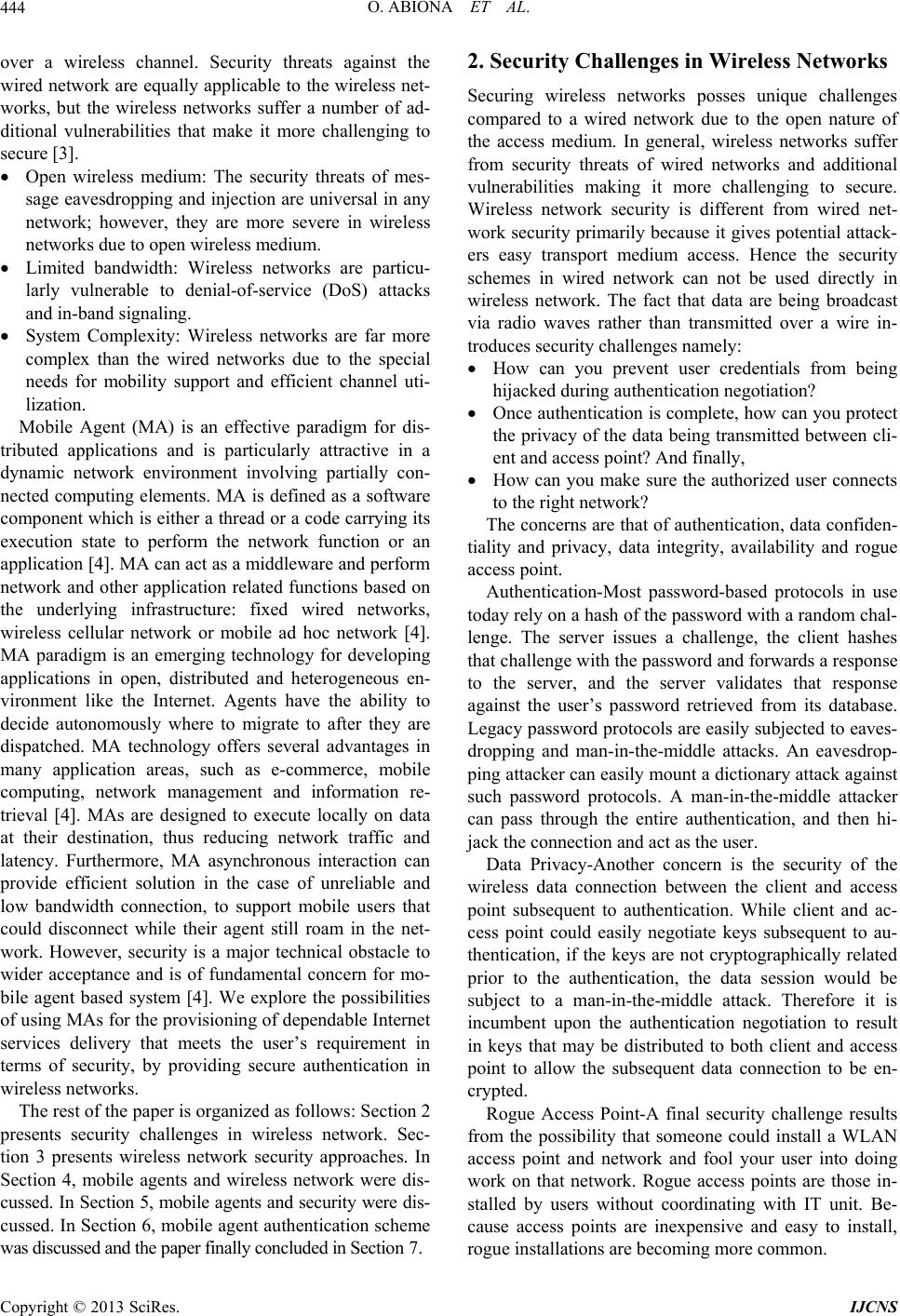
O. ABIONA ET AL.
444
over a wireless channel. Security threats against the
wired network are equally applicable to the wireless net-
works, but the wireless networks suffer a number of ad-
ditional vulnerabilities that make it more challenging to
secure [3].
Open wireless medium: The security threats of mes-
sage eavesdropping and injection are universal in any
network; however, they are more severe in wireless
networks due to open wireless m e di um .
Limited bandwidth: Wireless networks are particu-
larly vulnerable to denial-of-service (DoS) attacks
and in-band signaling.
System Complexity: Wireless networks are far more
complex than the wired networks due to the special
needs for mobility support and efficient channel uti-
lization.
Mobile Agent (MA) is an effective paradigm for dis-
tributed applications and is particularly attractive in a
dynamic network environment involving partially con-
nected computing elements. MA is defined as a software
component which is either a thread or a code carrying its
execution state to perform the network function or an
application [4]. MA can act as a middleware and perform
network and other application related functions based on
the underlying infrastructure: fixed wired networks,
wireless cellular network or mobile ad hoc network [4].
MA paradigm is an emerging technology for developing
applications in open, distributed and heterogeneous en-
vironment like the Internet. Agents have the ability to
decide autonomously where to migrate to after they are
dispatched. MA technology offers several advantages in
many application areas, such as e-commerce, mobile
computing, network management and information re-
trieval [4]. MAs are designed to execute locally on data
at their destination, thus reducing network traffic and
latency. Furthermore, MA asynchronous interaction can
provide efficient solution in the case of unreliable and
low bandwidth connection, to support mobile users that
could disconnect while their agent still roam in the net-
work. However, security is a major technical obstacle to
wider acceptance and is of fundamental concern for mo-
bile agent based system [4]. We explore the possibilities
of using MAs for the provisioning of dependable Internet
services delivery that meets the user’s requirement in
terms of security, by providing secure authentication in
wireless networks.
The rest of the paper is organized as follows: Section 2
presents security challenges in wireless network. Sec-
tion 3 presents wireless network security approaches. In
Section 4, mobile agents and wireless network were dis-
cussed. In Section 5, mobile agents and security were dis-
cussed. In Section 6, mobile agent authen tication scheme
was discussed and the paper finally concluded in Section 7.
2. Security Challenges in Wireless Networks
Securing wireless networks posses unique challenges
compared to a wired network due to the open nature of
the access medium. In general, wireless networks suffer
from security threats of wired networks and additional
vulnerabilities making it more challenging to secure.
Wireless network security is different from wired net-
work security primarily because it gives potential attack-
ers easy transport medium access. Hence the security
schemes in wired network can not be used directly in
wireless network. The fact that data are being broadcast
via radio waves rather than transmitted over a wire in-
troduces security challenges namely:
How can you prevent user credentials from being
hijacked during authentication negotiation?
Once authentication is complete, how can you protect
the privacy of the data be ing transmitted between cli-
ent and access po int? And f inally,
How can you make sure the authorized user connects
to the right network?
The concerns are that of authentication, data co nfiden-
tiality and privacy, data integrity, availability and rogue
access point.
Authentication-Most password-based protocols in use
today rely on a hash of the password with a random chal-
lenge. The server issues a challenge, the client hashes
that challenge with the password and forwards a response
to the server, and the server validates that response
against the user’s password retrieved from its database.
Legacy password protocols are easily subjected to eaves-
dropping and man-in-the-middle attacks. An eavesdrop-
ping attacker can easily mount a dictionary attack against
such password protocols. A man-in-the-middle attacker
can pass through the entire authentication, and then hi-
jack the connection and act as the user.
Data Privacy-Another concern is the security of the
wireless data connection between the client and access
point subsequent to authentication. While client and ac-
cess point could easily negotiate keys subsequent to au-
thentication, if the keys are not cryptographically related
prior to the authentication, the data session would be
subject to a man-in-the-middle attack. Therefore it is
incumbent upon the authentication negotiation to result
in keys that may be distributed to both client and access
point to allow the subsequent data connection to be en-
crypted.
Rogue Access Point-A final security challenge results
from the possibility that someone could install a WLAN
access point and network and fool your user into doing
work on that network. Rogue access points are those in-
stalled by users without coordinating with IT unit. Be-
cause access points are inexpensive and easy to install,
rogue installations are becoming more common.
Copyright © 2013 SciRes. IJCNS